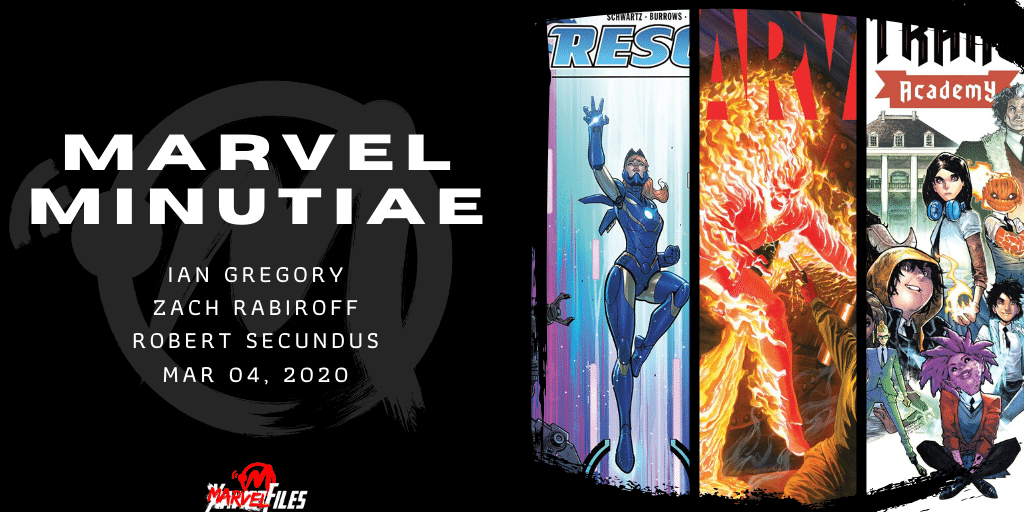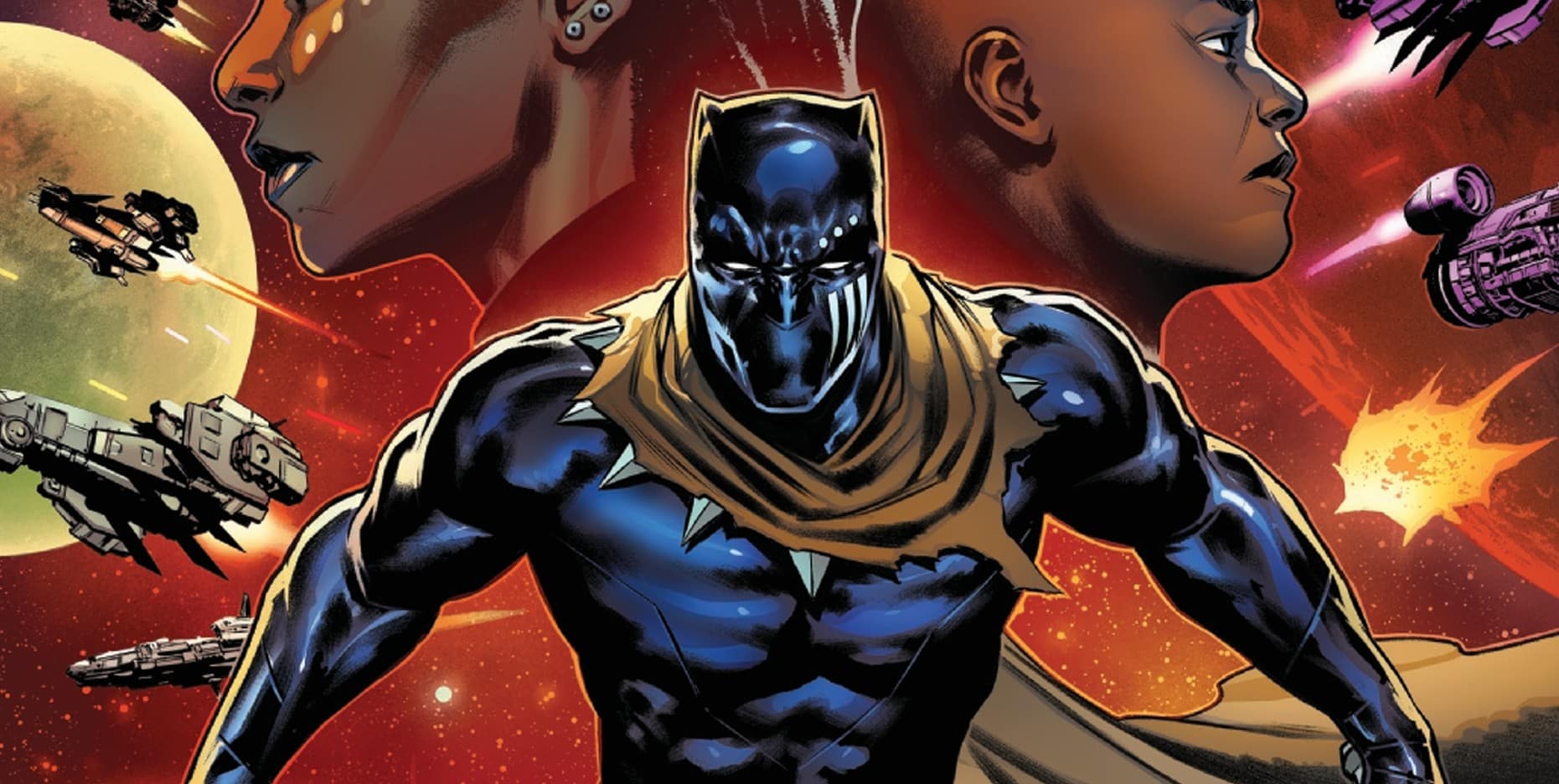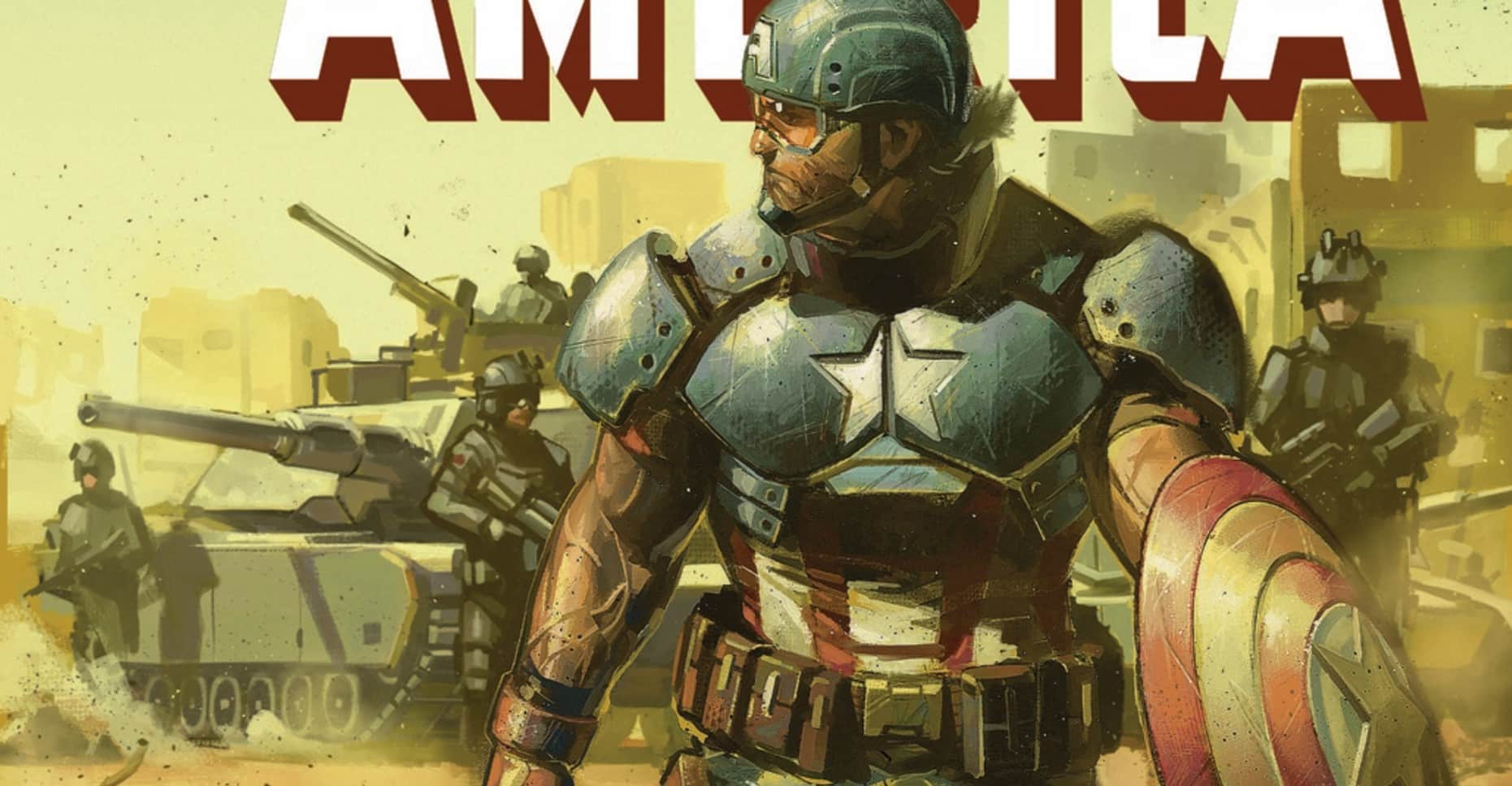Hello friends and readers and welcome to another week of Marvel Minutiae! We have a full grab bag this week as Rob Secundus covers Schwartz and Burrows’ Rescue 2020, Ian Gregory starts off Young and Ramos’ Strange Academy, and Zach Rabiroff tackles the premiere of Ross and Busiek’s (and others’) Marvel!
Rescue 2020 #1
Rescue 2020 packs a lot into its 20 some pages. It catches the reader up on the comics’ Pepper Potts’ entire life, on her current status quo, on her history as Rescue, her marriage with Happy Hogan, and said husband’s demise. It also takes an interesting angle on the Robot Rebellion at the heart of the Iron Man 2020 event, as it follows a small group of adorably monstrous robots that want to share not just rights with humanity, but art. They want humanity as well as equality with humanity.
That makes the issue sound a lot stuffier than it is. Keys– the taser-trigger-happy walking keyboard who generates beautifully incomprehensible song-lyrics– is absolutely hilarious [Ed. Note: Rocky Mountain Hiiiigh]. But its presence still raises interesting questions related to the event’s premise. If these robots can’t even write a song lyric, not a good lyric, mind you, just an intelligible one, then can they even pass the turing test? A Chuck-E-Cheese animatronic (with the brand filed off) leads a protest in this week’s Iron Man 2020 #3. Are the artificial intelligences fighting for humanity to approach non-sentient things as if they were sentient?
Is the central conflict of this massive crossover over giving your Alexa the right to vote? Or is everything automated in the 616 outfitted with an AI? If that’s the case, why haven’t we seen that in other comics? Doesn’t that move the universe into the distant future?
(And hey, aren’t the characters in Marvel’s best-selling line of comics right now creating a new society with the sole purpose of fighting the inevitable singularity? Why aren’t they involved?)
The weird thing about Rescue 2020 is that it’s an extremely fun comic, a comic that’s well worth your time, but also a comic that at every page lead me to wonder whether the broader 2020 story itself is worthwhile. That aforementioned conflict with Keys clears right up; as soon as the pretense of holding humans hostage disappears, those same humans agree to stick around and help Keys keep working on its musical development. The threat of real violence is really nothing more than a threat, and humans and machines, as soon as they’re given the opportunity to choose to do so without compulsion, freely and quickly decide to work together.
But it doesn’t just stop with 2020. When I finished reading Rescue, my first thought was “I’d really love to read a Rescue ongoing!” And my second thought was “I’m really not excited to read Tony Stark’s ongoing!”
The comic opens with a montage of Pepper’s overachieving childhood. Her university’s president tells her that they expect her to go on to great things; she immediately becomes Tony Stark’s secretary. Throughout the issue she’s tasked with procuring DNA from Tony Stark’s mother, that Tony’s body might be rebuilt and the original Iron Man return to leading his own book. His mother isn’t a fan; she admonishes Pepper, “at some point we need to move on.”
And I really think we do.
It seems that there’s no other way for this story to end than Tony’s triumphant return as he seizes the throne from his brother. And I just don’t know what use Tony is to the 616 at this point. The MCU proves that a Marvel universe can do just fine without him. In our own world, a world of Bloombergs and Musks, we’re less and less likely to see “Billionaire Playboy” as anything other than cartoonishly villainous. In the 616, I think there’s a reason why Iron Man spent the better half of a decade Inverted, in a coma, or replaced by Doctor Doom and Riri Williams (and now Arno Stark).
What is there to say about Tony Stark? What stories are there left to tell?
But Pepper Potts, and the other characters that have received their own one-shots in this event– there might be a few left stories left to tell about them. I hope, when it all wraps up, Marvel gives some of them a chance.
Robert Secundus is an amateur-angelologist-for-hire.
Strange Academy #1
Hope Summers has defeated the Dark Phoenix, and in doing so released its powers of rebirth all over the globe. New mutants are finally being born, and to meet their need for educa- err, hold on. What I mean is, magic has returned to Earth, and to meet the rising need for education of young magicians, Dr. Strange has opened up the first ever academy for magically gifted youngsters. There’s a lot in the basic premise that’s familiar to X-fans, but Skottie Young and Humberto Ramos give Strange Academy plenty of unique charm.
A school book, mutants or otherwise, requires an interesting cast of students, and most of this issue is a cavalcade of character introductions. Ramos is clearly having fun drawing the diverse cast, which includes a handful of humans, a demon from limbo, a fairy, Asgardians in man buns, a frost giant, and Dormammu’s polo-shirt wearing son [Ed. Note: His name is literally Doyle and I’m upset]. Though this is a lot of characters thrown at us in just a few pages, their designs are memorable and their brief interactions reveal plenty of personality – and grounds for future conflict. Teen drama is the lifeblood of X-Men school books, but making characters too aggressive or boneheaded can be more frustrating than fun (see: New Mutants, vol. 2).
With the exception of the four humans (though one may be in question), the students are each from a different dimension. The inaugural class represents Asgard, Jotunheim, Otherworld, Weirdworld, Limbo, and the Dark Dimension. Even if we haven’t seen these particular characters before, there’s a lot of history between their homeworlds which has carried over into how they view each other. Further distinguishing the students is their mix of magical abilities, which are displayed in a beautiful and colorful action sequence. Ramos clearly has a blast with the tentacles, alien gore, and various magical effects.
The teachers are a good mix of Marvel’s established magic characters, though we only really get to see doctors Voodoo and Strange in action here. I do have some concerns regarding the teaching staff – mainly if Nico Minoru should be put in charge of teaching anyone, and why Magik is calmly standing next to THE PRETENDER, WANDA MAXIMOFF. Nevertheless, it’s a promising group whose familiarity balances the new students.
While on first look the focus of the cast seems to be on the other-dimensions aspect of Marvel magic, Young has promised that the school’s setting in New Orleans will factor heavily into the story. Marvel’s magical stories have traditionally strayed far from actual historical magical practices, and most magician characters seem to simply have super powers with extra steps. This issue hints that different characters have different magical specialties, and Strange Academy’s setting provides the perfect opportunity to expand this corner of Marvel into new directions (though it is my fervent hope that if Young dips into hoodoo for stories, it’s more The Conjure Woman than White Zombie).
Ian Gregory is a writer and co-host of giant robots podcast Mech Ado About Nothing.
Marvel #1
The 30th anniversary of the landmark Kurt Busiek/Alex Ross series Marvels has been greeted by its publisher by something midway between celebration and incontinence. In addition to last year’s remastered and annotated edition of the original series, an additional epilogue chapter, and a hardcover collection of the above, no fewer than four new series are on the docket, each with a different permutation of the Marvel’s title, and each with a different sort of tenuous relationship to the evergreen classic.
This week sees the first issue of Marvel, a rather belated release of Ross’s original, rejected Marvels pitch for an anthology series in which hand-picked artists and writers would be given a wide berth to tell stories set throughout Marvel history. This inaugural issue contains two full stories: a Spider-Man/Rhino fight plotted and drawn by Frank Espinosa and scripted by Sajan Saini, and a fight between the original Avengers and the Hulk written by Kurt Busiek and drawn by Steve Rude, along with a framing sequence painted by Ross himself.
The results, as might be expected from such a venture, are mixed. Espinosa’s Spidey tale is a muddy, muddled mess: illustrations that might make a charming if disorienting children’s book result in a nauseatingly unclear battle sequence, while Saini’s scripting feels bizarrely off-voice, capturing none of the humor of classic Spider-Man while trying to compensate with an overflow of words per panel. Busiek and Rude’s contribution is a stronger affair, with Busiek evoking something of the charming atmospherics, heartfelt characterization, and evident love of Marvel history that made his Untold Tales of Spider-Man tick, while Rude’s drawings have all the storytelling clarity and hyperkinetic energy that a Jack Kirby pastiche demands [Ed Note: It also contains MANY Hulks]. And Ross’s bookends, for their part, are gorgeous to behold, if entirely slight in actual story.
But what all of these pieces have in common is an almost deliberately incurious sense of nostalgia. The ostensible advantage of a series like this is the freedom it gives creators to tell offbeat, unusual stories with Marvel characters that couldn’t or shouldn’t exist within the confines of typical comics. Yet nothing here would be out of place as the C-story in an average annual. Espinosa and Ross seem largely concerned with the frame-worthiness of their pictures (why not just bite the bullet and call it a pin-up collection?), while Busiek’s contribution, entertaining and well-crafted as it is, never seeks to rise above the obedient love-letter to Lee and Kirby that it clearly is. There is no sense of purpose underneath the comic book navel-gazing, nothing to say except to remind us how good things were back in the good old days.
The original Marvels succeeded not just because it voiced a love for Marvel history, but because it was willing to probe, prod, and question it. It asked its readers to evaluate the worthiness and relevance of their shared cultural past even as it ultimately reaffirmed them. But if the original item gazed at the Marvel Universe with the skeptical eyes of an outsider, its sequel merely blinks at it with placid, valedictory approval. It might be worth remarking that the creators on display here mostly resemble Ross himself — in gender, in age, and largely in cultural background. Some more diversity, and a lot more curiosity about worlds both real and fictional, might have made this anniversary more worthy of celebration.
Zach Rabiroff works daily at a charity, and is also a freelance writer and editor. He reads a lot of comics.








